|
| Patellar Tendonitis (Jumper's Knee)Patella tendonitis (also known as Jumper's Knee and Sinding-Larsen-Johansson disease) is a painful condition affecting the patellar tendon (also called the patellar ligament or anterior ligament) in the knee joint. Like all forms of tendinitis, patellar tendinitis is a condition that can flare up and subside over a period of time. Inflammation in the patellar tendon is often due to irritation and/or micro-tearing of the collagen fibers. When the fibers tear, they become weaker, inflamed and swollen causing pain and tenderness in the area. Tendons, by nature, receive very little blood flow. This prevents certain areas of the tendons from getting adequate blood supply in order to repair and maintain themselves. This makes tendons prone to micro-tearing and inflammation if they are strained or overused. There are 2 types of tendonitis, acute and chronic. Acute tendonitis refers to inflammation that comes on suddenly, usually from a tendon strain or overloading it during exercise. Chronic tendonitis occurs over time and generally results from long term repetitive use of the patella tendon. With both types of patellar tendinitis, scar tissue develops on the tendon as the tears begin to heal. This scar tissue mends the tears in an abnormal way leaving the collagen fibers weaker and less flexible and its presence can result in re-tearing the same small areas over and over. The patellar tendon connects the shin bone (tibia) below the (patella) kneecap to the quadriceps femoris tendon above the kneecap. The fibres of the patellar tendon encase the patella itself, allowing it to glide up and down. The patellar tendon is responsible for extending the knee with the help of the quadriceps femoris tendon which passes down both sides of the patella and the quadriceps femoris muscle in the upper leg - a process known as the quadriceps mechanism. Other conditions which can be a cause of anterior knee pain are commonly confused with patellar tendonitis. These conditions include quadriceps tendonitis, chondromalacia(mendmyknee.com), patello-femoral subluxation and hyper-pressure, fat pad impingement or Hoffa's Syndrome, and patello-femoral arthritis. Symptoms of Patellar Tendonitis You might be suffering from Patellar Tendonitis if:
 If any of those statements are true for you or you're suffering from on-going pain under your knee cap (patella) then you might have an injury called "Patellar Tendonitis". This type of tendonitis is usually an injury that athletes get, but it can happen to individuals who aren't athletes as well. Anyone - young or old - can suffer from this injury, and if you're active this condition will keep you from doing the things you love to do. It will even start interrupting your normal daily tasks and make living life harder than it really needs to be. Patellar Tendonitis CausesTendonitis is a condition that is micro-tearing in the tendon tissue. When the knee is overworked or overstressed the damage to the soft tissue is done. Jumpers knee is most common in an aging athlete who is involved in 'jumping' sports such as basketball, volleyball and jogging. Patella Tendonitis can be caused by repetitive use of the patellar tendon, but can also be caused by trauma such as a blow to the knee. This condition is most common in an athlete who is involved in "jumping" sports such as basketball, gymnastics, figure skating, and volleyball. Other risk factors include: There are a variety of internal and external causal factors for patellar tendonitis. Some outside factors would include overuse of your knee, wearing shoes that don't give you proper support, or athletic activity / exercising too much, too fast or for too long. Some internal factors include your age, flexibility, and the natural alignment of your feet, calves, knees and thighs. 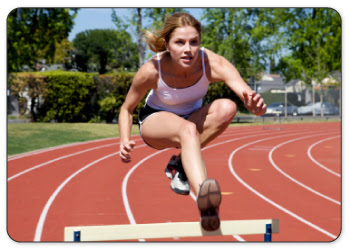
The Patellar Tendon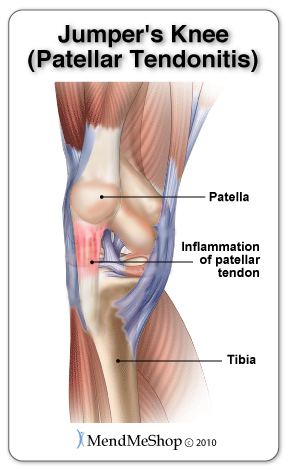 The knee joint is made-up of 4 bones: the femur (thigh bone), fibula & tibia (shin bone), and the knee cap. The knee cap is a sesamoid bone, which means that it is a bone that's embedded in a tendon. For the knee cap this means that above the knee cap is the quadriceps tendon and below the knee cap is the patellar tendon. The patellar tendon attaches the knee cap, quadriceps tendon and quadriceps muscle to the shinbone below the knee. All of these elements work together to function as the "quadriceps mechanism" to help you when straightening your knee / leg. The patellar tendon plays an important role in the way you use your leg muscles. The patellar tendon helps your muscles extend your knee so that you can kick a ball, run uphill and jump up in the air. This is why patella (patellar or 'infrapatellar') tendonitis is often called 'Jumper's knee'. Patellar TendinopathyJumper's Knee and patellar tendinopathy is a general term used to describe any kind of injury that causes irritation, tearing, or inflammation in the patellar tendon. There are different kinds of patellar tendinopathy that can happen that will influence how long you suffer from this injury, what type of treatment is needed and how to prevent further injury to your patellar tendon. 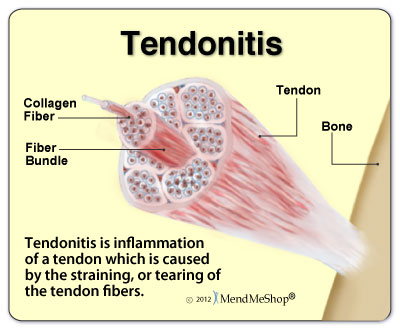 Patellar TendonitisShort-term inflammation in the patellar tendon is considered 'patellar tendonitis'. This is where the tendon becomes frayed or torn from an incident (like playing sports / running), or over-use (repetitively participating in the same activities). You may partially or completely tear your patellar tendon. If you completely tear your patellar tendon, your tendon will no longer be attached to your knee cap (patella). Without that attachment you won't be able to straighten your knee. Partial tearing usually happens to the middle of the patellar tendon, while complete tearing often happens where the patellar tendon connects to the knee cap (patella). 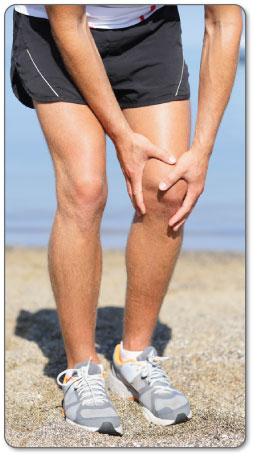 Patellar TendinosisPatellar tendinosis happens when the tendon gets worn out over a long period of time (from overuse or aging of the tissue) and becomes damaged. This type of injury causes the tendon to thicken and micro-tear. Usually with tendinosis there isn't a lot of swelling or inflammation, just chronic, long-lasting pain. Patellar TenosynovitisIf the protective lining of your tendon (called the 'tendon sheath') becomes irritated or damaged this is called 'tenosynovitis'. This condition happens to the inner lining of the sheath, and this irritation can happen from injury, overuse, or repetitive tasks. Patellar Tendonitis DiagnosisA visit to your doctor is the best way to know if you have patellar tendonitis. To properly diagnose your knee pain your doctor will ask about your medical history, your current condition and symptoms. They will ask your about the intensity of your present pain, how long you've had these symptoms and the limitations you're experiencing. Details about what you think may have caused the problem, when it started, and whether or not you have ever had treatments for this or a similar condition in the past, are very helpful in assessing your injury. 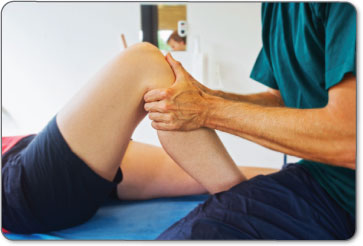 There are 2 tests your doctor may perform to decide if you have a patellar tendon injury:
Both of these physical tests will help your doctor to determine a correct diagnosis of your knee pain. If for any reason the test(s) don't help to discover the source of your pain, then diagnostic testing (an X-ray and/or MRI) will be ordered. These tests are also often used to rule out other conditions. 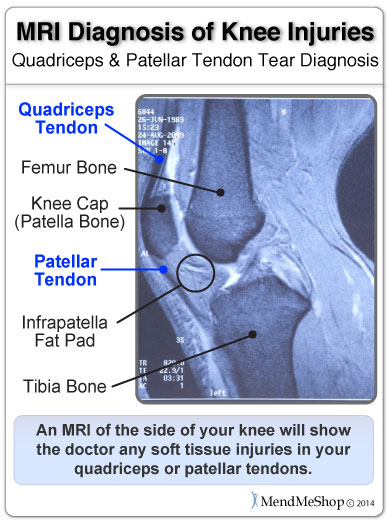 X-rays will provide a 2-dimensional image of the overall structure of your knee. They're helpful in identifying knee instability, abnormal bone shapes (bone spurs or bone cysts, fractures, wear and tear on the joints). MRIs (magnetic resonance imaging) will provide more detailed information and will help to evaluate the soft tissues in and around your knee (muscles, tendons, ligaments, menisci and other connective tissues). It can identify ligament or tendon damage, and can help to determine the extent of your injury, the displacement and degree of your tear or inflammation, as well as other associated knee conditions. Patellar Tendonitis Home Conservative Treatment OptionsStep 1 - Reduce Pain and Swelling with Cold CompressionThe first step for conservative treatment of your kneecap tendonitis is to reduce the swelling to "open up" the area for more blood flow. Anyone in the health-care business knows that your blood supplies the oxygen and much needed nutrients required to heal foot tendonitis injuries. This is why for years, doctors, trainers, and other medical professionals have recommended RICE (Rest, Ice, Compression, Elevation) to treat the pain and swelling of fresh injuries, chronic pain, and after any re-injury. This is important because once blood vessels are blocked or damaged, they can no longer carry oxygenated blood to your damaged tendon and tissues begin to break-down. Without cold compression, tissues break down further because they can't get the oxygen they need to survive. By limiting the amount of damage done to your tendons, you also limit the amount of healing that needs to occur. This is a very important step to heal acute or chronic tendon injuries faster and with less pain! Step 2 - Enhance Circulation, Soften Scar Tissue & Reduce Risk of Re-Injury with a TShellz Wrap®After the inflammation in your knee has been reduced, moving the tendon and applying a local circulatory stimulation device like the Knee TShellz Wrap® is really we recommend for completing the recovery cycle.
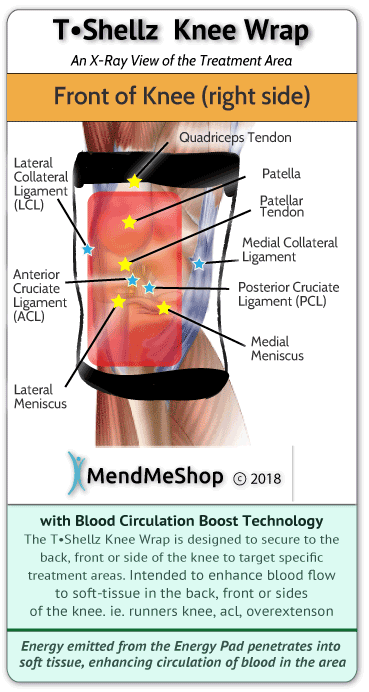 Increased Blood Circulation = Increased Healing CapabilityTShellz Wraps® contain a unique Carbon Fiber Energy Pad which is flexible and will shape to conform to your body. This Energy Pad emits a uniform wave of perfectly safe energy over its entire surface. This energy is absorbed by soft tissue in the treatment area, opening blood vessels, resulting in an increase in blood flow. Increased blood circulation is what your body needs to accelerate the healing of soft tissue and this is why we recommend the TShellz Wrap®. The Knee TShellz Wrap® is an FDA Registered Medical Device and is suitable for use in therapeutic clinics and FROM HOME. It is completely safe for people and patients to use for themselves. The technology found in a TShellz Wrap® has been used for decades in the worlds of professional and amateur sports - a contributing factor as to why athletes seem to recover from injuries so quickly. Have you ever wondered by an athlete can return to activity after 3 to 6 weeks following a knee injury - while your average person takes much longer to return back to normal? The secret isn't really that much of a secret - it involves consistent treatments (meaning multiple times a day) using a device similar to the TShellz Wrap® to stimulate blood flow to the injured tissues. Most athletes have the luxury of using in-house facilities many times per day. How many us can afford the time and money to visit a clinic multiple times a day? Very few indeed. This is how you can gain some of the advantages that athletes enjoy in their injury recovery - by using a device like the TShellz Wrap® two or three times a day on a consistent basis. Consistent Treatments = Consistent And Long Term ImprovementWhat Else Makes the Knee TShellz Wrap® So Special?We believe the TShellz Wrap® to be one of the most effective home treatments to increase localized blood flow in and around the treatment area. We can promise that you will receive a product that is designed to be safe and does what it is supposed to do... reduce pain (as stated in "Therapeutic Heat and Cold", 4th edition. - Ed. Justus F. Lehmann, M.D., Williams, and Wilkin) temporarily increase length & flexibility of soft tissue (as stated in "Therapeutic Heat and Cold", 4th edition. - Ed. Justus F. Lehmann, M.D., Williams, and Wilkin) and aid your body in recovering from tendon, muscle and other soft tissue injuries via enhanced blood flow. 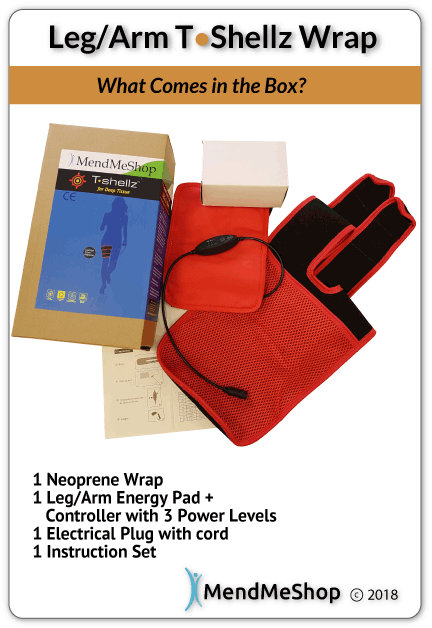 The unit plugs into a standard wall outlet to get its power. The nice thing about the power supply is that the same unit can be used in North America and overseas as well. It has the capability to operate between 110v and 230v. The TShellz Wrap® has a special signal controller that can be set for 3 different power levels of application (3=High, 2=Medium, 1=Low). The cord is long enough that you can sit or lie comfortably and watch TV, read or surf the net while you're using it. Treatments are max 30 minutes in duration and the device can be worn over clothing. This allows you to use the device at work, at home, or really anywhere you have access to an electrical outlet. Use a Knee TShellz Wrap®:
Use a Cold Compress or Ice Pack:
What Else Makes the TShellz Wrap® So Special?We believe the TShellz Wrap® to be one of the most effective treatments to stimulate blood flow to tissue in the treatment area. We can promise that you will receive a product that is designed to be safe and does what it is supposed to do...quickly relieve pain and aid in the recovery from tendon, muscle and other soft tissue injuries. The unit plugs into a standard wall outlet to get its power. The nice thing about the power supply is that the same unit can be used in North America and overseas as well. It has the capability to operate between 110v and 230v. It has a special signal controller that can be set for 3 different power levels of application (3=High, 2=Medium, 1=Low). The cord is long so you can sit or lie comfortably and watch TV, read or surf the net while you're using it. We recommend 5 to 10 minute treatments to start; the safety shutoff controller is set to max 30 minutes in duration. The device can be worn over clothing and allows you to use the device at work, at home, or really anywhere you have access to an electrical outlet. Product Advisors are available 9:00 am to 5:00 pm Eastern Standard Time Monday to Friday. Learn More About Tendon Injuries & TreatmentsI want to learn more about Post-Surgery Recovery I want to learn more about TShellz Wrap® Circulatory Boost I want to learn more about Ice & Heat: Which Is Better For Treatment? I want to learn more about Tendonitis Treatments I want to learn more about Tendonitis Surgery FREE SHIPPING ON ALL PRODUCTS CURRENTLY ENABLED |
       |








